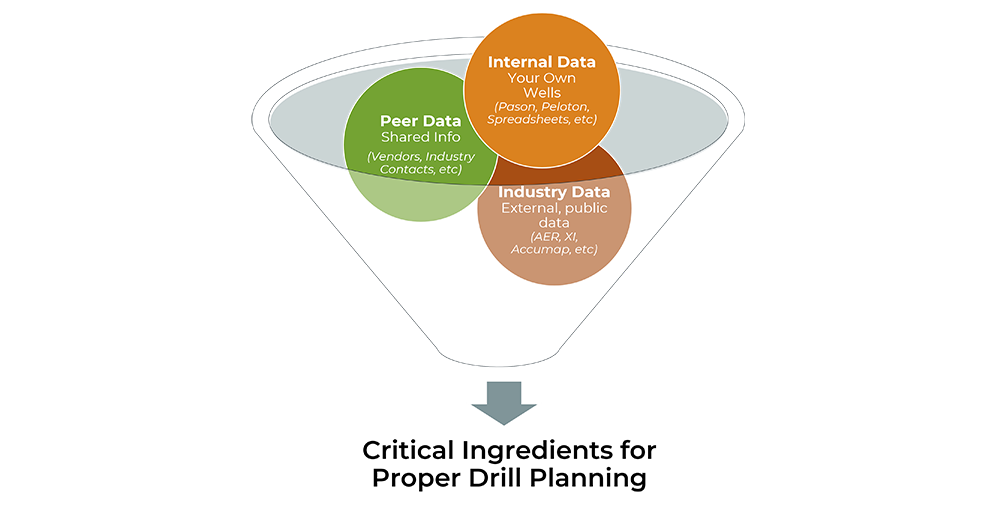Word to the Wise: Why data balance is the key to a successful drill plan
August 30, 2022
Each week, XI Technologies scans their unique combination of enhanced industry data to provide trends and insights that have value for professionals doing business in the WCSB. If you’d like to receive our Word to the Wise in your inbox, subscribe here.
When planning a drilling program, the information gathering phase is critical to the success of the drilling project. Before a bit can break ground, you need to have an estimated drill time, an approach to take to setting kickoff point, a plan to minimize tripping, an understanding of what problems to anticipate, and an unbiased assessment of what equipment/suppliers are most likely to deliver the desired results.
There are a lot of ways to get this information and the quality of that information could be the difference between a successful drilling program or not. The following are the three main sources of that data and why they are important.
Internal information
Internal information comes from your past experiences in the planned area. What learnings have you picked up from drilling similar wells? How much data have you accumulated firsthand? At XI, we frequently hear from clients and prospects that they know the area they’re drilling in, having gained hard won data and experience by drilling there for years. This gives them a confidence that they know what they need to know and don’t need to look for outside sources of information for new wells in the same area.
And there’s something to this idea. Information you gain internally can be incredibly valuable. As the saying goes, experience is the best teacher, and thus there’s no replacement for the firsthand knowledge gained in an area.
However, just relying on your own internal information, even if it’s backed by extensive experience in the area, can lead to planning in a bubble. You don’t know what you don’t know and thus will be benchmarking only against yourself, without knowing how you compare to other drills in the area. It’s difficult to know if alternative techniques or technology would improve or harm performance if all your information is based on your own past techniques and technology.
Relationships
Another way to collect drill planning information is to seek input from peers, suppliers, vendors, consultants, etc. There is value in the knowledge gained from suppliers and vendors with experience in an area, and from subject matter experts. This is particularly useful if your own knowledge of the area is limited. As many drilling departments saw staffing reductions during the downturn, there’s been a big push toward this outsourcing of information gathering and expertise.
But be careful not to blur the lines between input and decision making. How much of your decision-making apparatus do you want outsourced to people not responsible for the results? If you’re relying on vendors, suppliers, or bid processes to help you acquire data, how unbiased do you expect it to be? The very nature of the bidding process demands companies position themselves as the best choice available. And when depending on the data collection capabilities of a third-party provider, a lot of the information you get from relationships will tend toward anecdotal, rather than fact-based, data-driven evidence.
External data
The third major way to gather drill planning information is by collecting external data of past drilling in an area from available sources. This can provide you with a wider-spread, objective perspective, using detailed information about specific wells of interest. Using public records through software solutions and data suppliers, and research and analysis based on past drilling by other operators, puts the control in your hands. OffsetAnalyst is an example of software that allows users to access and analyse nearly 200,000 digital tour reports for detailed drilling plans.

When you use external data in your drilling plans, you can benchmark your performance with competitors as well as yourself. It gives you a view of what others in the area have tried, giving you the option to test and validate ideas you might have for your upcoming drills. This data is independent and impartial, giving control to your analysts to explore and interpret it as they see fit.
A proper balance
While current conditions stress the importance of external data, it doesn’t mean there isn’t a place for internal information or relationships as valuable sources of information in drill planning. All these sources are valuable methods of collecting information for your drill plan, complementing each other for a complete picture. No single source is sufficient by itself. The key to a successful drill plan is to find a proper balance of information sources, and to use them to validate each other.
To discover how XI can help you with the external data portion of this balance, visit our website or book a personalized demo of our OffsetAnalyst software. You can also download a paper on how a client found success in their drill planning by using it.
